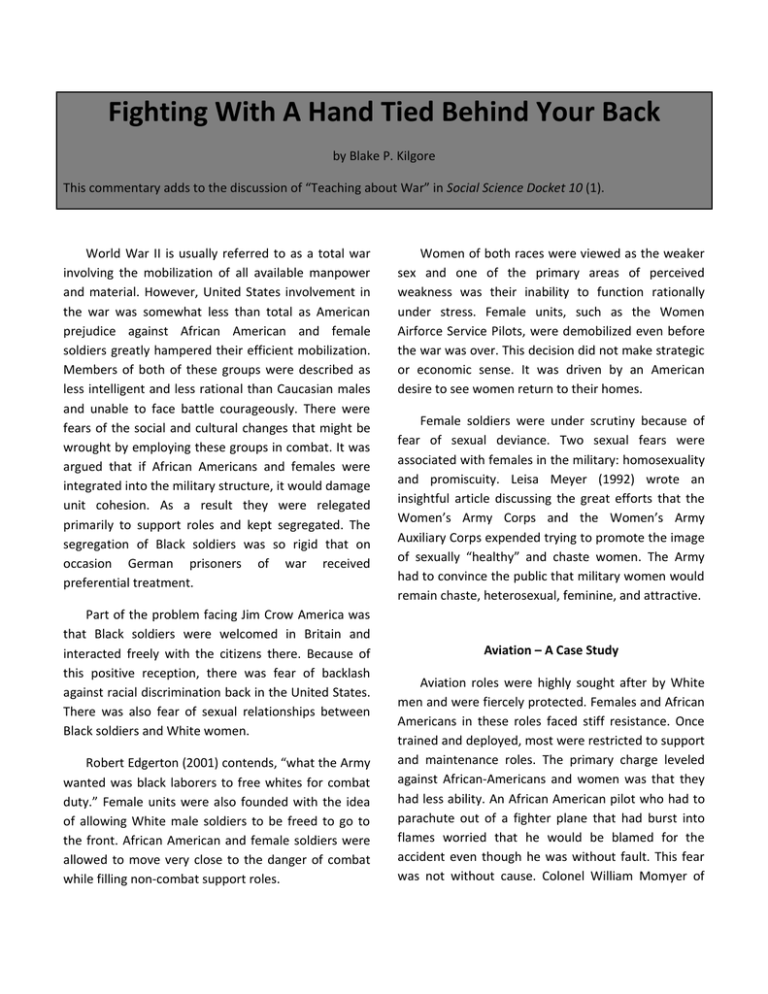
Fighting With A Hand Tied Behind Your Back
by Blake P. Kilgore
This commentary adds to the discussion of “Teaching about War” in Social Science Docket 10 (1).
World War II is usually referred to as a total war
involving the mobilization of all available manpower
and material. However, United States involvement in
the war was somewhat less than total as American
prejudice against African American and female
soldiers greatly hampered their efficient mobilization.
Members of both of these groups were described as
less intelligent and less rational than Caucasian males
and unable to face battle courageously. There were
fears of the social and cultural changes that might be
wrought by employing these groups in combat. It was
argued that if African Americans and females were
integrated into the military structure, it would damage
unit cohesion. As a result they were relegated
primarily to support roles and kept segregated. The
segregation of Black soldiers was so rigid that on
occasion German prisoners of war received
preferential treatment.
Part of the problem facing Jim Crow America was
that Black soldiers were welcomed in Britain and
interacted freely with the citizens there. Because of
this positive reception, there was fear of backlash
against racial discrimination back in the United States.
There was also fear of sexual relationships between
Black soldiers and White women.
Robert Edgerton (2001) contends, “what the Army
wanted was black laborers to free whites for combat
duty.” Female units were also founded with the idea
of allowing White male soldiers to be freed to go to
the front. African American and female soldiers were
allowed to move very close to the danger of combat
while filling non-combat support roles.
Women of both races were viewed as the weaker
sex and one of the primary areas of perceived
weakness was their inability to function rationally
under stress. Female units, such as the Women
Airforce Service Pilots, were demobilized even before
the war was over. This decision did not make strategic
or economic sense. It was driven by an American
desire to see women return to their homes.
Female soldiers were under scrutiny because of
fear of sexual deviance. Two sexual fears were
associated with females in the military: homosexuality
and promiscuity. Leisa Meyer (1992) wrote an
insightful article discussing the great efforts that the
Women’s Army Corps and the Women’s Army
Auxiliary Corps expended trying to promote the image
of sexually “healthy” and chaste women. The Army
had to convince the public that military women would
remain chaste, heterosexual, feminine, and attractive.
Aviation – A Case Study
Aviation roles were highly sought after by White
men and were fiercely protected. Females and African
Americans in these roles faced stiff resistance. Once
trained and deployed, most were restricted to support
and maintenance roles. The primary charge leveled
against African-Americans and women was that they
had less ability. An African American pilot who had to
parachute out of a fighter plane that had burst into
flames worried that he would be blamed for the
accident even though he was without fault. This fear
was not without cause. Colonel William Momyer of
the 33rd Fighter Group treated the 99th Fighter
Squadron, an all-Black force, as a burden. In a scathing
review that was published in Time magazine and
received broad exposure, Momyer portrayed the 99th,
which was forced to train at segregated facilities at
the Tuskegee Institute, as cowardly and
uncooperative.
Meanwhile female pilots were never militarized.
Yet despite being restricted from combat missions,
female pilots ferried aircraft, served as engineering
test pilots, trained ground crews in searchlights,
towed gliders, were flight instructors, and assisted in
bomber crew training Merryman (1998). In these
missions they performed as well or better than male
counterparts in the same roles.
References
Edgerton, R. (2001). Hidden Heroism: Black Soldiers in
America’s Wars. Boulder, CO: Westview Press.
Meyer, L. (1992). “Creating G.I. Jane: The Regulation
of Sexuality and Sexual Behavior in the Women’s Army
Corps During World War II.” Feminists Studies 18, no.
3, 581-601.
Merryman, M. (1998). Clipped Wings: The Rise and
Fall of the Women Airforce Service Pilots (WASPs) of
World War II. New York, NY: University Press.



